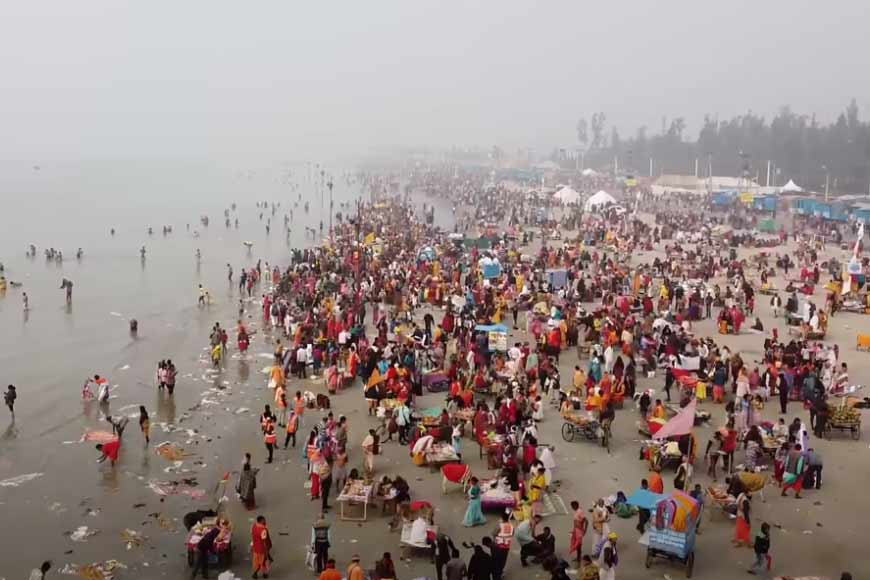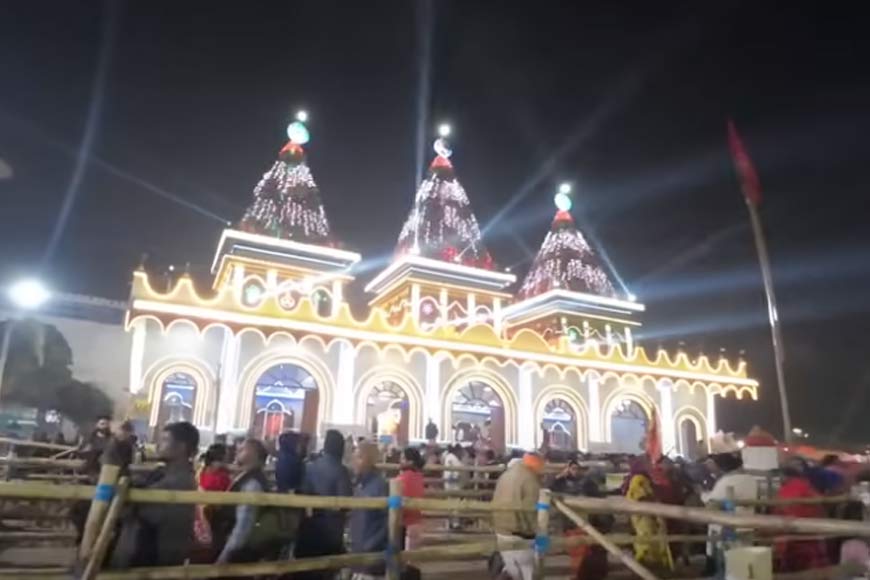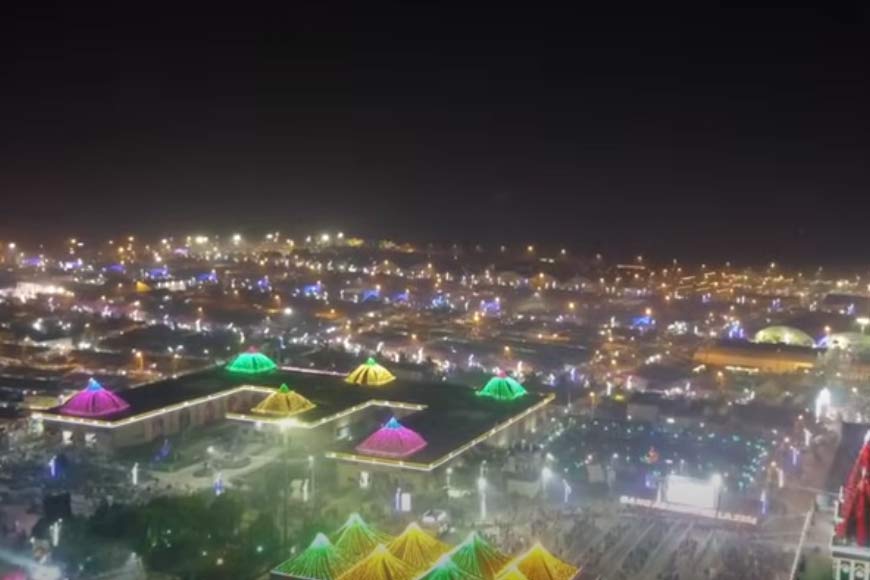Gangasagar Mela: Does Faith override the ‘Environmental Sustainability’ of Sagar Island? - GetBengal story

Gangasagar Mela, Gangasagar, West Bengal
The depth of the sunrise could not be fathomed across the vast horizon of the river mouth where only throngs of black and white heads can be seen along with a flush of occasional saffron robes, swaying in the chilling wind of a wintry January pre-dawn. The sub-zero water of the Sagar is enough to stall the rhythm of a healthy heartbeat, yet faith can keep your heart going, it can overcome the hardships of physical displeasure and run along the trajectory of a spiritual high that can annihilate every bit of scientific data, can lead to the mass destruction of the environment and even be the cause of the ill effects of hazardous pollution that can lead to a disaster for the future generations.
 Kapil Muni Temple,Gangasagar, West Bengal
Kapil Muni Temple,Gangasagar, West Bengal
The twilight dawn at the Gangasagar Mela on Makar Sankranti however is oblivious to such dangers, none ever speaks about the impact of the famous Gangasagar Mela on the future environmental sustainability of the fragile Sagar Island. Rather the ill effects of such huge congregations of humans on a fragile ecosystem are easily ignored. As environment biologist Dr Rupak Dhali who has also done studies on Marine Ecosystems of the East Coast of India says: “Faith has overridden the ecosystem and even media never portrays how the Gangasagar Mela held in part of the largest delta of the world ie Sundarbans is wreaking havoc in the area annually. It is considered just a one-day affair, but none counts what happens on that one day and how many congregate in the area almost a month before the actual Mela starts and how the structures erected as temporary shelters for pilgrims cause immense damage to the marine life around.”
Also read : Not just a holy dip!
Sagar Island is part of the Sundarbans island complex with an area of nearly 240 sq. km where a complex interplay of natural dynamics and human intervention is actually posing a threat to the sustainability of the island. Rishab Manna of the ‘Save Sagar’ campaign mentions in this regard: “Sagardwip always faces impacts of adverse anthropogenic activities and socio-ecological practices. It is a fragile coastal zone and though Gangasagar Mela generates major income for the island dwellers, it causes immense organic pollution of the water bodies around. The pollution potential of the annual gathering on water bodies in and around Sagar Island including the Bay of Bengal is really scary and when my team compared last year the pre- and post-gathering water samples, a tremendous water quality degradation was observed. The total fecal coliform bacteria count went up that led to mass-scale public health issues including dysentery and hospitalisation.”

As per tests and reports submitted by various research groups, the worst source of pollution was at the festival ground itself. Sagar Island is the largest island in the whole of Sundarbans and we are all aware, thanks to the frequent cyclonic systems over the area and ever-increasing population, the island system is on the brink of destruction. The net land loss of the island due to erosion in the last 30 years has been nearly 30 sq km. Yet one cannot ignore the Gangasagar Mela which is a big-time revenue earner in the area. As economist Bankim Banerjee mentions: “Economy and Revenue always come before environment in India, specially post-Covid when locals need money and Gangasagar Mela is one of the largest revenue earners for the state of West Bengal. How can that be stopped? Few lakhs of pilgrims from all over India visit the place every year and nearly 2,00,000 of them prefer staying in the area itself for 2-5 days. Their wastes quite naturally pollute adjacent streams, rivers and coastal areas. The same story we found in pollution of the Ganges, be it in 1896 when Mark Twain visited Varanasi where he described the Ganga as ‘nasty’ because of the ‘foul gush’ of its sewers or present-day Gangasagar Mela where pilgrims pollute the mouth of the famous Ganga that meets the sea here.”
The decay of waste materials decreases oxygen levels in the waters, thus directly affecting marine life, and killing fishes and the menace continues. A 2011 study shows in the field of organic pollution in rivers, India has one of the worst scenarios. As per the Cleanganga website report, organic pollution in Indian rivers is 1.4 times the world average, partly because of excessive levels of human waste, which are three times larger than elsewhere and 50 times the standards set by the World Health Organization. Government clean-up efforts started in the 1960s and coordinated into the ‘Ganga Action Plan’ in 1985. In the case of Sagar, the problem is recurrent though for a short time. And if we look into the revenue model of the Mela, one realizes it cannot be ignored. It is believed to involve Rs 20 million and create an estimated 67500 man-days of jobs in the informal sector. Locals get themselves involved directly or indirectly during the Ganga Sagar Mela through various types of business such as transport, marketing, food & lodging etc. Since millions of pilgrims of different socio-cultural statuses come, an amalgamation of socio-cultural scenarios takes place.
 Makar Sankantri celebration at Gangasagar Mela brings in a renewed spiritual awakening within us
Makar Sankantri celebration at Gangasagar Mela brings in a renewed spiritual awakening within us
A comparative study of environmental parameters led by the Environmental Science department of Jadavpur University indicated a degradation of the quality of the environment basically by human waste, and it showed a persistent nature for at least one to two months, and that is alarming indeed! The worst affected parameter of the environmental quality was found to be the bacterial count of the surface water followed by the hardness and dissolved Oxygen. While the enhancement of fecal coliform count was between 1.5 to 34 times depending upon the specific site locations during the GSM period, the depletion of dissolved oxygen was at most 7 percent, with up to 80 percent increase in hardness. Comparatively higher degradation of seawater quality concerning organic pollution has been reported at the Eastern side of Sagar Beach at Dhablat, where the Sagar Canal meets the Bay of Bengal. The maximum organic pollution was found at Canal near Jhauban, which is nearest to the temporary toilet complex and also an area of fish drying. Even after two months of the Mela, a high count of coliform prevailed in the sampling point behind Kapilmuni ashram, an area with regular pilgrim activities. Even the beach water continued to have a high coliform count in general. The people of the villages situated at the northern part of the fairground complained of the obnoxious smell and attacks of dysentery, amoeboisis etc. in post-Mela season.

However, efforts have been made consistently by the State Government and local environmental bodies to restrict the prolonged stay at the fairground and clean the environment. Proper bio-toilets are being made. Faith will continue to reign in India, one however needs to be aware of how that faith does not override rationality and scientific knowledge. Only a clean and green environment will be able to sustain the world in the future.
Data References:
1. Hazra S., Baksi A., Environmental refugees from vanishing islands, Environment and Human Security, Jadavpur University, 219-228 (2003).
2. Hazra S., Sen G., Ghosh T., Samanta K. and Baksi A., Impact of Sea level Rise in Sundarbans (Abstract), National Seminar on Vulnerability of Sundarban Mangrove Ecosystem in the Perspective of Global climate change, June 14-15, (2002).
3. Basak C.M., Pilgrimage on the ocean- development of Sagar Island, Bay of Bengal, Oceans ’04 MTTS/ IEEE Techno- Ocean ’04, 2, 954- 958 (2004).
4. Hajra et al. Int. J. Res. Chem. Environ. Vol. 2 Issue 1 January 2012(140-144)











